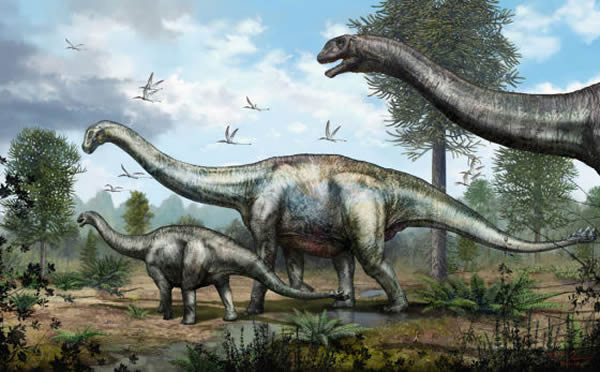Listen to part of a lecture in a zoology class.
聽一段動物學課程。
Your reading for today touched on dinosaur fossils from the Mesozoic era, which ended about 65 million years ago.
你們今天的閱讀材料講的是中生代時期的恐龍化石,中生代在六千五百萬年前結束。
Today we will be discussing the sauropods.
今天我們要講的是蜥腳類動物。
I think our discussion of sauropods will illustrate what we can learn by comparing the fossil record to modern animals.
我認為,我們對蜥腳類動物的討論能告訴我們,將化石和現代動物對比,我們能學到什么。

By fossils, we mean traces of prehistoric animals such as bones, which become mineralized, or impressions of bones or organs that are left in stone.
化石是指史前生物的遺跡,比如已經礦化的骨頭和骨頭或器官在石頭上留下的印記。
Now sauropods were among the largest animals to exist ever!
有史以來,在存在過的動物中,蜥腳類動物是體型最大的。
They were larger than blue whales, which are the largest animals alive today.
它們比藍鯨還大,而藍鯨是現存動物中最大的。
They weigh up to one hundred tons, twenty times as much as elephants.
蜥腳類動物體重能達到100噸,是大象體重的二十倍。
Also, they were an extremely successful kind of dinosaur.
并且它們作為恐龍而言是很成功的。
There's evidence of sauropods in the fossil record for an unusually long time, over one hundred million years.
有化石證據顯示,蜥腳類動物的存在時間長得有些不尋常,超過了一億年。
So, why were sauropods so successful?
為什么蜥腳類動物這么成功?
Biologically speaking, sauropods shouldn't have been successful.
從生物學角度來看,蜥腳類動物不應該這么成功。
Large animals like elephants, say, they require much more food and energy and have fewer offspring than smaller animals.
大型動物(如大象)比起體型更小的動物而言,需要更多的食物和能量,而后代更少。
This makes maintaining a population harder.
這就使維持一定的種群數量變得更加困難。
The largest animals today don't live on land, but in the ocean where food is easier to find.
現在,體型最大的動物不生活在陸地上,而是生活在更容易覓食的海洋里。
A blue whale, for instance, can eat up to 8,000 pounds of food a day.
舉個例子,一只藍鯨一天能吃掉八千磅的食物。
And they give birth only once every few years.
而且它們每隔幾年才繁衍一次。
We also know that body heat, that… well, large animals can't easily get rid of excess body heat.
我們還知道體溫……大型動物不容易散去多余體溫。
But for an oceangoing whale, that's not a problem.
對于在海里生活的鯨魚來說,這不是問題。
For a 100-ton land animal, it can be.
但對于一百噸的陸生生物而言,就是個問題了。
For years, we have assumed it was the abundant plant life of the Mesozoic that allowed these giants to thrive.
多年來,我們都以為,是中生代時期的豐富植物讓這些巨型動物繁榮起來。
However, we now know that since oxygen levels were much lower in the Mesozoic than we assumed, there was much less plant life for sauropods to eat than we thought.
但我們現在知道了,由于中生代的氧氣含量比我們所以為的要低得多,在那時候并沒有我們想象中那么多的植物供蜥腳類動物食用。










